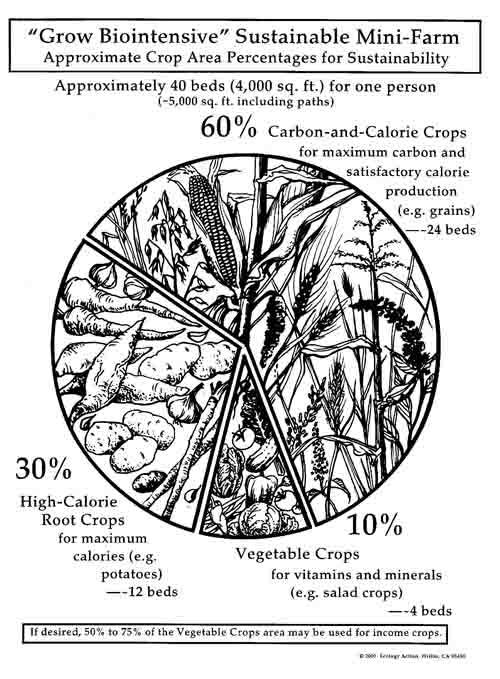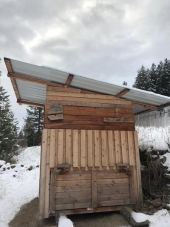
 2
2




Bee Putnam
 2
2




It's never too late to start! I retired to homestead on the slopes of Mauna Loa, an active volcano. I relate snippets of my endeavor on my blog : www.kaufarmer.blogspot.com
 2
2




 2
2




CLARIFICATIONS AND EXAMPLES
(General Aids for Planning Your Diet)
• 60-65% of the area — "Carbon-and-Calorie Crops" — High-Carbon-producing and
significant-calorie-producing (weight-efficient [see below]) crops
Grains: Wheat, Cereal Rye, Oats, Barley, Triticale, Corn, Sorghum, Amaranth, Quinoa, etc.
Fava Beans (grown to maturity for dry bean and dry biomass production)
Sunflowers (sunflower seeds very high in fat; maximum to avoid copper toxicity = 0.62 lb / day)
Filberts
Raisins
• 30% of the area — "High-Calorie Root Crops" — Area- and weight-efficient crops for calories
Crops for this category need to be both area- and weight-efficient. As defined for this worksheet, a crop is considered to be "area-efficient" if the annual area needed for total calories is 16 beds (1600 sq ft) or less, assuming GROW BIOINTENSIVE intermediate yields; it is considered to be "weight-
efficient" if the daily weight of food to be eaten for total calories is 9 pounds or less.1
Potatoes (12.2/6.7) Maximum to avoid potassium toxicity = 2.5 lb /day
Jerusalem Artichoke (12.3 / 7.0)**
Garlic (10.8 / 3.6)**
Leeks (6.6 / 8.7)
Parsnips (10.8 / 7.1)
Sweet Potatoes (11.2 / 5.0)
Salsify (11.8 / 6.5)
AREA in 100-sq-ft beds / WEIGHT in lb: e.g., it takes 12.2 beds of potatoes to produce the 2,400 calories per day needed by an average person—who would have to eat 6.7 lb of potatoes per day.
** Jerusalem artichoke and some varieties of hard-neck garlic may produce significant amounts of dry biomass.
The crops below are weight-efficient, but require more area to grow and produce relatively little biomass. Therefore, they should be included in the 10% "Vegetable Crops" category.
Peanuts (34.1 / 0.9) Very high in fat
Soybeans (58.0 / 3.8)
Beans (except Fava Beans) (56.8 / 4.7)
Burdock (17.8 / 7.3) (assuming Carrot yield)
Cassava (20.1 / 3.3) May produce modest amount of carbon
The following crops can be area-efficient if yields are high enough, but the daily weight of food exceeds the guidelines, so they should be included in the 10% "Vegetable Crops" category.
Onions, Regular (12.7 / 14.0)
Turnips + Tops (8.8 / 19.4) (assuming 2 crops are possible OR yield is two times intermediate)
Rutabaga (13.4 / 14.7)
NOTE: For diet diversity, you may choose crops that are less weight-efficient (e.g. regular onions, 14.0 lb per day); in which case, you need to have a significant amount of food from crops that are more weight-efficient (e.g. filberts (0.8 lb per day) and/or increase your design area.
ROOT CROPS THAT ARE NOT GOOD CHOICES FOR THIS CATEGORY:
Carrots (30.0 / 12.3)
Beets / Mangels (roots only) (40.8 / 12.3)
Radishes (48.1 / 26.4)
• 5-10% of the area — "Vegetable Crops"
Low-calorie-producing, low-carbon-producing miscellaneous vegetables for vitamins and minerals
Iterations are fine, we don't have to be perfect
My 2nd Location:Florida HardinessZone:10 AHS:10 GDD:8500 Rainfall:2in/mth winter, 8in/mth summer, Soil:Sand pH8 Flat
 5
5




 2
2





Idle dreamer
 1
1




Sometimes the answer is nothing

 1
1








I imagine that this would also need a long growing season. I have lived both in California with an 11 month growing season and in the Midwest with a shorter growing season, and an acre of California land will raise many times what an acre of Kansas last can raise, because the growing season is longerTyler Ludens wrote:Ecology Action has determined that it takes a minimum of 4000 square feet to grow a nearly nutritionally complete vegan diet for one adult using Biointensive growing methods. This amount of land is under good conditions. Poor land or difficult conditions will require more area. Using different methods is likely to require more area.
http://www.growbiointensive.org/grow_main.html
 2
2




Ken W Wilson wrote:Fruit and nut trees would be a good addition.


 1
1




Iterations are fine, we don't have to be perfect
My 2nd Location:Florida HardinessZone:10 AHS:10 GDD:8500 Rainfall:2in/mth winter, 8in/mth summer, Soil:Sand pH8 Flat
 1
1




Living a life that requires no vacation.


 1
1
 1
1




Iterations are fine, we don't have to be perfect
My 2nd Location:Florida HardinessZone:10 AHS:10 GDD:8500 Rainfall:2in/mth winter, 8in/mth summer, Soil:Sand pH8 Flat
 1
1










Living a life that requires no vacation.




 1
1




A build too cool to miss:Mike's GreenhouseA great example:Joseph's Garden
All the soil info you'll ever need:
Redhawk's excellent soil-building series









Bee Putnam
 1
1




 1
1




Ken W Wilson wrote: I just like variety.
A build too cool to miss:Mike's GreenhouseA great example:Joseph's Garden
All the soil info you'll ever need:
Redhawk's excellent soil-building series







 1
1




Iterations are fine, we don't have to be perfect
My 2nd Location:Florida HardinessZone:10 AHS:10 GDD:8500 Rainfall:2in/mth winter, 8in/mth summer, Soil:Sand pH8 Flat




Stacy Witscher wrote:I think that the major thing most people leave out is fat.





|
Inside every old person is a young person wondering what happened. And waving this tiny ad:
turnkey permaculture paradise for zero monies
https://permies.com/t/267198/turnkey-permaculture-paradise-monies
|





